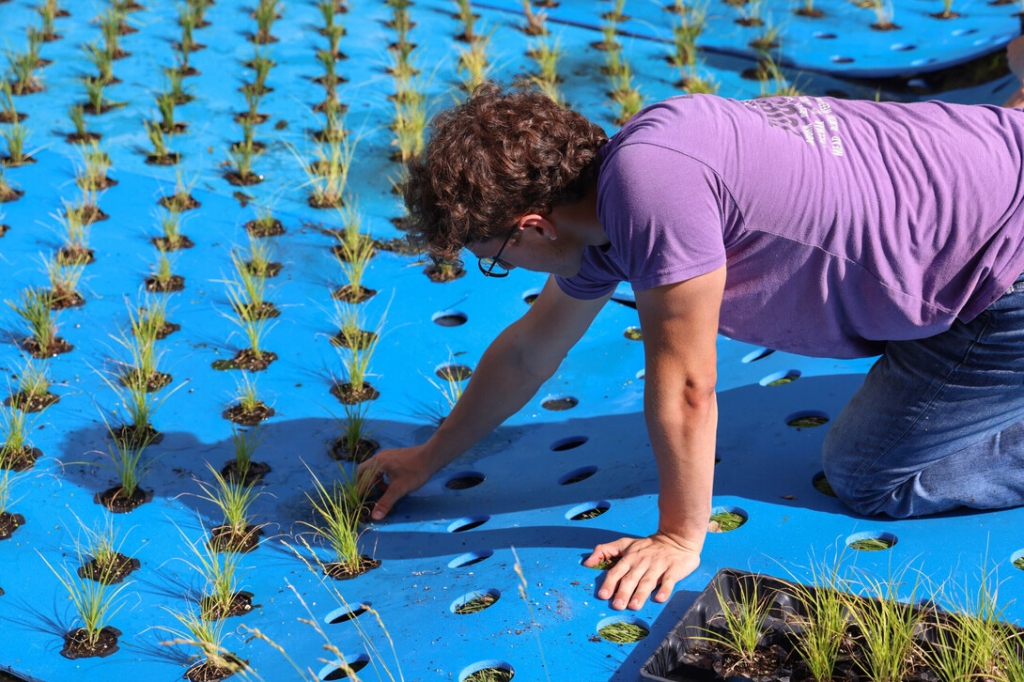Alexandra Coffelt, August 12, 2024
Project aims to improve water quality of Lincoln ponds
A University of Nebraska–Lincoln team is leveraging the power of plants to combat nutrient pollution in urban ponds. Led by soil and water chemist Steve Comfort and watershed hydrologist Aaron Mittelstet, Husker students installed two floating wetlands in Lincoln’s Fox Hollow neighborhood on June 14.
The pair of wetlands contains close to 2,000 lance-fruited oval sedges from the Nebraska Statewide Arboretum fastened into foam rubber mats. Students gathered at the pond’s edge and constructed a PVC and landscape netting framework before snapping each potted sedge into the mats.
The seven students involved in the installation represented undergraduate programs across East Campus. Calen Pollard, a junior biological systems engineering major, said he has worked on the floating wetlands project in Mittelstet’s lab since last winter.
Becca Cain, a junior environmental science major, paddled a kayak across the pond to find the best locations to anchor each of the floating structures. She also helped maneuver the treatment system’s two airlift pumps into place.
The pond, like many in Lincoln, has experienced unchecked algae and weed growth due to high levels of nitrates and phosphates in the water. Comfort said that the main sources of these pollutants are fertilizers and animal waste — from both pets and wildlife.
Comfort and Mittelstet received grant funding from the Environmental Protection Agency to treat five ponds this summer and five more in 2025. Mittelstet said that tentative plans for an installation near Lincoln Christian School would provide an opportunity to engage even more students in conversations about water quality.
“Part of this is also education,” he said. “I’m going meet with the science teacher at Lincoln Christian, and the goal is to integrate our treatment project into their science curriculum. I would love for the students to assist us in the wetland installation and post-treatment water quality monitoring.”
Vertical openings in each pot allow the plants to stretch their roots into the water as they grow. The sedges absorb nitrogen and phosphorus, while microbes living on the root systems convert nitrates into harmless nitrogen gas.
“Plants are good at taking up nitrogen and denitrifying,” Comfort said, “And we’re using a chemical approach to get rid of the phosphate.”
This part of the treatment plan involves slowly adding aluminum sulfate, more commonly known as alum, through two airlift pumps in the pond. Each pump takes in water, mixes in some of the alum and returns the treated water to the pond.
The team used a lanthanum composite in its initial study, Mittelstet said, but switched to alum because it is less expensive and more readily available to the public.
Aluminum sulfate bonds with phosphate molecules to neutralize their polluting effects, and the circulation process creates bubbles that add oxygen to the water. As nitrate and phosphate levels fall, algae populations die off and the water clears.
This two-pronged approach is unique in the realm of water-quality improvement. The combination of biological and chemical treatments directly addresses the nutrient pollution that underpins algae overgrowth, with benefits that extend into Nebraska’s waterways.
“It’s not just for that pond,” Mittelstet said. “It will also reduce the nutrients in downstream waterbodies such as Salt Creek.”

The inaugural installation at a pond in Lincoln’s Densmore Park greatly reduced the amount of phosphorus and nitrogen over a three-year period. These impressive algae control results helped convince Fox Hollow residents to partner with the university for this recent installation.
Homeowners’ association president Ann Schroeder said that Comfort taught residents closest to the pond how to maintain the pump system, recommended phosphorus-free fertilizers and explained the timeline for noticeable results.
“Steve said the pond was going to look bad for two years, but that’s fine,” she said. “I’m sure it’s going to work because I’ve been around to other ponds … that the university has done and they look great.”
Comfort said that buildup on the pond floor is to blame for this waiting period. When a pond experiences nutrient pollution, normal plant growth dies off and oxygen-producing photosynthesis cannot occur. Fallen leaves and other organic matter fail to decompose without oxygen and instead accumulate at the bottom of the pond.
“We can treat what’s in the water column pretty fast,” he said, “but we’ve got to get the water clear and then start decomposing that muck.”
Graduate students at Nebraska have worked to quantify just how well these systems improve water quality over time. Matthew Chaffee, advised by Mittelstet, revisited two installation sites to investigate changes in chlorophyll concentrations and biodiversity of the ponds’ aquatic life. Jenna McCoy, advised by Comfort, analyzed how effectively the floating wetlands removed nitrate from treated ponds.
The project has also inspired innovation for the next generation of floating wetlands. Levi McKercher, who authored the original paper on the Densmore Park installation, is now exploring organic alternatives to foam rubber mats as a doctoral student at the University of South Carolina.
“These students all came to try to do something for the environment,” Comfort said. “This type of project is a hands-on way for them to do that. That’s why I think it’s so valuable and why they enjoy working on it, because they feel like they’re contributing to fixing a problem.”





